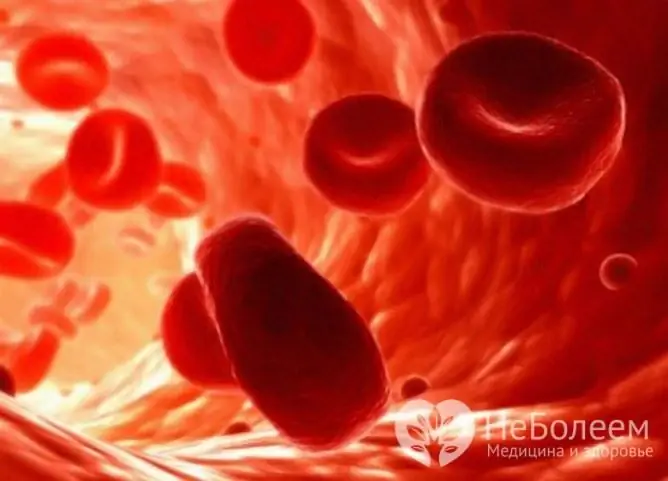- Author Rachel Wainwright [email protected].
- Public 2023-12-15 07:39.
- Last modified 2025-11-02 20:14.
RBC in a blood test - what is it?
The content of the article:
- Clinical blood test
- RBC in the blood test: the norm in children
- RBC blood test decoding: the norm in women
- Decoding RBC in a blood test: the norm in men
- Reasons for the deviation of the content of red blood cells in the blood from the norm
The abbreviation RBC in the blood test refers to erythrocytes (from the English red blood cells, red blood cells). Erythrocytes are blood cells whose main function is to carry oxygen from the lungs to all tissues of the body.

Iron gives the red color to red blood cells - these cells are mainly composed of hemoglobin, a compound of protein and iron
About 2.4 million red blood cells are formed in the bone marrow of healthy people every day. Before entering the bloodstream, they lose their nucleus and many organelles. Almost their entire cavity is filled with hemoglobin - a combination of protein and iron. It is hemoglobin that gives red blood cells a red color, for which they got their name - red blood cells. However, young red blood cells (called reticulocytes) contain very little hemoglobin and are therefore gray and even blue in color. Normally, their number should not exceed 2-4% of the total number of erythrocytes.
A separate RBC blood test is not prescribed. This number is one of the indicators that make up the general blood test, the indications for which are:
- dispensary and preventive observation;
- examination of pregnant women;
- diagnostics of anemias;
- examination of patients with somatic and infectious diseases (prescribed simultaneously with a biochemical blood test);
- diagnostics of diseases of the hematopoietic system.
If necessary, for example, if RBCs are increased in the blood test, an in-depth study may be prescribed - a detailed clinical blood test, which includes the determination of erythrocyte indices:
- MCV is the average volume of one erythrocyte;
- MCH is the average content of hemoglobin in one erythrocyte;
- MCHC - the concentration of hemoglobin only in the erythrocyte mass, and not in the total blood volume;
- RDW - the width of the distribution of erythrocytes, that is, the presence and concentration of red cells in the blood that are significantly different in size from the norm;
- ESR - ESR, erythrocyte sedimentation rate (outdated ROE, erythrocyte sedimentation reaction).
Clinical blood test
A clinical (general) blood test is the most common laboratory test prescribed for examining patients, including during clinical examination. It includes counting the number of blood cells (erythrocytes, leukocytes, platelets), determining the hemoglobin concentration, erythrocyte sedimentation rate, the relative content of leukocyte subpopulations and a number of other parameters.
All these parameters in the results forms have certain designations, abbreviations of English terms:
- RBC (red blood cells) - erythrocytes or red blood cells;
- WBC (white blood cells) - white blood cells or leukocytes;
- HGB (hemoglobin) - the level of hemoglobin in whole blood;
- HCT (hematocrit) - hematocrit, an index representing the percentage of the volume of blood cells to the volume of blood plasma;
- PLT (platelets) - platelets;
- ESR (erythrocyte sedimentation rate) - ESR, erythrocyte sedimentation rate.
When performing an extended clinical blood test, erythrocyte, platelet, and leukocyte indices are additionally determined, which are also designated by certain abbreviations.
RBC in the blood test: the norm in children
During the period of intrauterine development, to ensure normal tissue respiration, the fetus needs a significantly larger number of erythrocytes and hemoglobin than an adult. After birth and the beginning of the functioning of the small circle of blood circulation, the need for an increased number of red blood cells disappears, as a result of which their content decreases. Therefore, the normal amount of RBC in the blood in children does not depend on gender, but only on age.
The norm of the content of erythrocytes in the blood in children
| Child's age | Erythrocyte count x1012 / l |
| 1-3 days | 4 to 7.2 |
| 4-7 days | 4 to 6.6 |
| 8-14 days | 3.6 to 6.2 |
| 2 weeks to 1 month | 3 to 5.4 |
| 2 months | 2.7 to 4.9 |
| 3-11 months | 3.1 to 4.5 |
| 1 year | 3.6 to 4.9 |
| 2-12 years old | 3.5 to 4.7 |
| 13-15 years old | 3.5 to 5.6 |
RBC blood test decoding: the norm in women
In women of childbearing age, the normal amount of erythrocytes in the blood is 3.5-4.7x10 12 / l. During the period of ovulation, their level decreases slightly, and a few days before the start of the next menstruation, on the contrary, increases. This increase is associated with the preparation of the body for the upcoming bleeding and the activation of bone marrow functions.
After 45 years, a gradual extinction of the functions of the ovaries begins. This process is accompanied by a change in the composition of the blood. The normal content of erythrocytes during this period slightly increases and is 3.6-5.1x10 12 / l. With the onset of menopause, the activity of physiological processes decreases, but the amount of RBC remains unchanged.
During pregnancy, the rate of red blood cells depends on the gestational age. In the first trimester, their number should be 3.9-4.8x10 12 / l. In the second trimester, blood volume begins to increase. In this case, the plasma volume increases more than the number of red blood cells. Therefore, at this time, the RBC indicator in the blood test is lowered and amounts to 3.9-4.8x10 12 / l. Starting from the third trimester, the woman's body prepares for childbirth and for the loss of a certain volume of blood. The bone marrow produces erythrocytes in large quantities, and by 35-36 weeks of pregnancy, their blood content reaches 4.1-5x10 12 / l. In the early postpartum period, as a result of blood loss, the content of red cells in the blood drops to 3-3.5x10 12/ l. Such a fluctuation in the number of erythrocytes during pregnancy does not mean any pathology, but is one of the mechanisms of physiological adaptation of the body to bearing and giving birth to a child.

The maximum content of erythrocytes in the blood is normally observed in newborns
Decoding RBC in a blood test: the norm in men
Men, unlike women, do not have regular monthly and other physiological blood loss. Therefore, the number of erythrocytes in their blood is not normally subject to significant fluctuations and is 4-5x10 12 / l.
Reasons for the deviation of the content of red blood cells in the blood from the norm
A condition in which the RBC is elevated in the blood is called erythrocytosis. It can be relative when there is a decrease in plasma volume, but the number of erythrocytes remains unchanged, and absolute when the number of red blood cells increases with the same plasma volume.
The causes of relative erythrocytosis are:
- dehydration (massive burns, repeated vomiting, diarrhea, insufficient fluid intake);
- obesity;
- severe stress;
- hypertensive crisis.
The development of absolute erythrocytosis can lead to:
- genetically determined disorders of hemoglobin synthesis;
- hypoxia (carbon monoxide poisoning, heart defects, respiratory diseases, smoking);
- kidney disease (hydronephrosis, polycystic kidney disease);
- malignant tumors.
A decrease in red blood cells in the blood is called erythropenia. Lead to its development:
- anemia;
- bleeding;
- leukemia;
- parasitic invasions;
- poor nutrition;
- AIDS;
- chronic alcoholism.
YouTube video related to the article:

Elena Minkina Doctor anesthesiologist-resuscitator About the author
Education: graduated from the Tashkent State Medical Institute, specializing in general medicine in 1991. Repeatedly passed refresher courses.
Work experience: anesthesiologist-resuscitator of the city maternity complex, resuscitator of the hemodialysis department.
Found a mistake in the text? Select it and press Ctrl + Enter.






